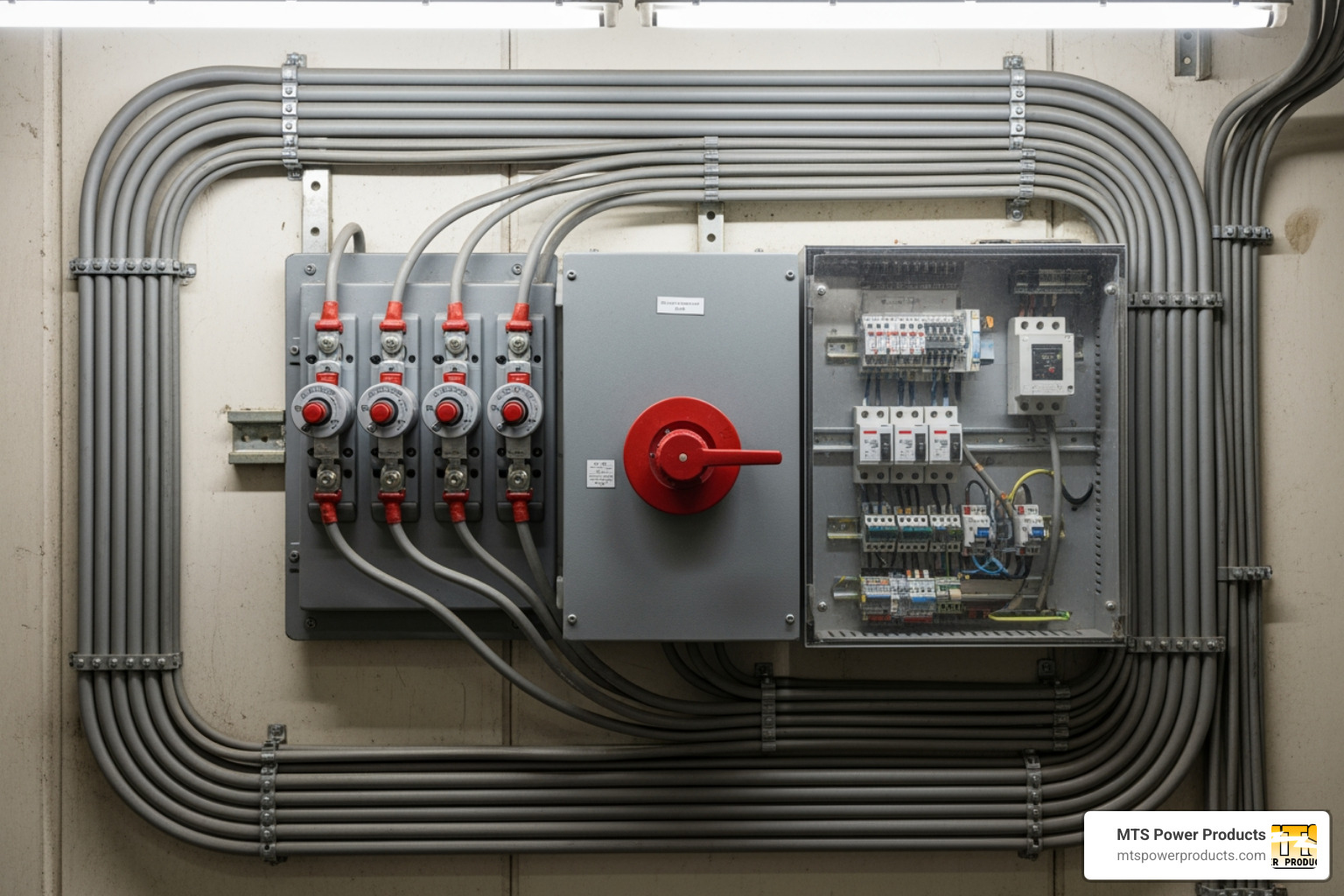
Buy Direct
from the Manufacturer
Sell our Products
Become a Distributor
Discounts
on volume purchases
Visit Us
at our Miami office
from the Manufacturer
Become a Distributor
on volume purchases
at our Miami office
Emergency generators have become essential equipment for homes and businesses as power grid reliability continues to decline across the United States. Over 40% of households have experienced a power outage in the last 5 years, and the demand for home backup generators has increased by 30% since 2020.
What are emergency generators?
Looking for examples from leading brands? Compare Generac home backup generators, Kohler home standby systems, Honda portable inverter generators, and Champion dual-fuel portables.
The statistics tell a sobering story. Natural disasters, aging infrastructure, and extreme weather events are making power outages longer and more frequent. For manufacturing operations, even a brief outage can halt production and cost thousands in lost revenue. For families in hurricane-prone regions like South Florida, a reliable generator means the difference between riding out a storm safely at home or evacuating to a shelter.
The numbers don’t lie – the global portable generator market is projected to reach $10.5 billion by 2027, growing at 5.1% annually. This isn’t just about convenience anymore. It’s about maintaining business continuity, protecting medical equipment, and ensuring family safety when the grid fails.
Whether you’re protecting a manufacturing facility or keeping your family comfortable during the next hurricane season, understanding your emergency power options has never been more critical.
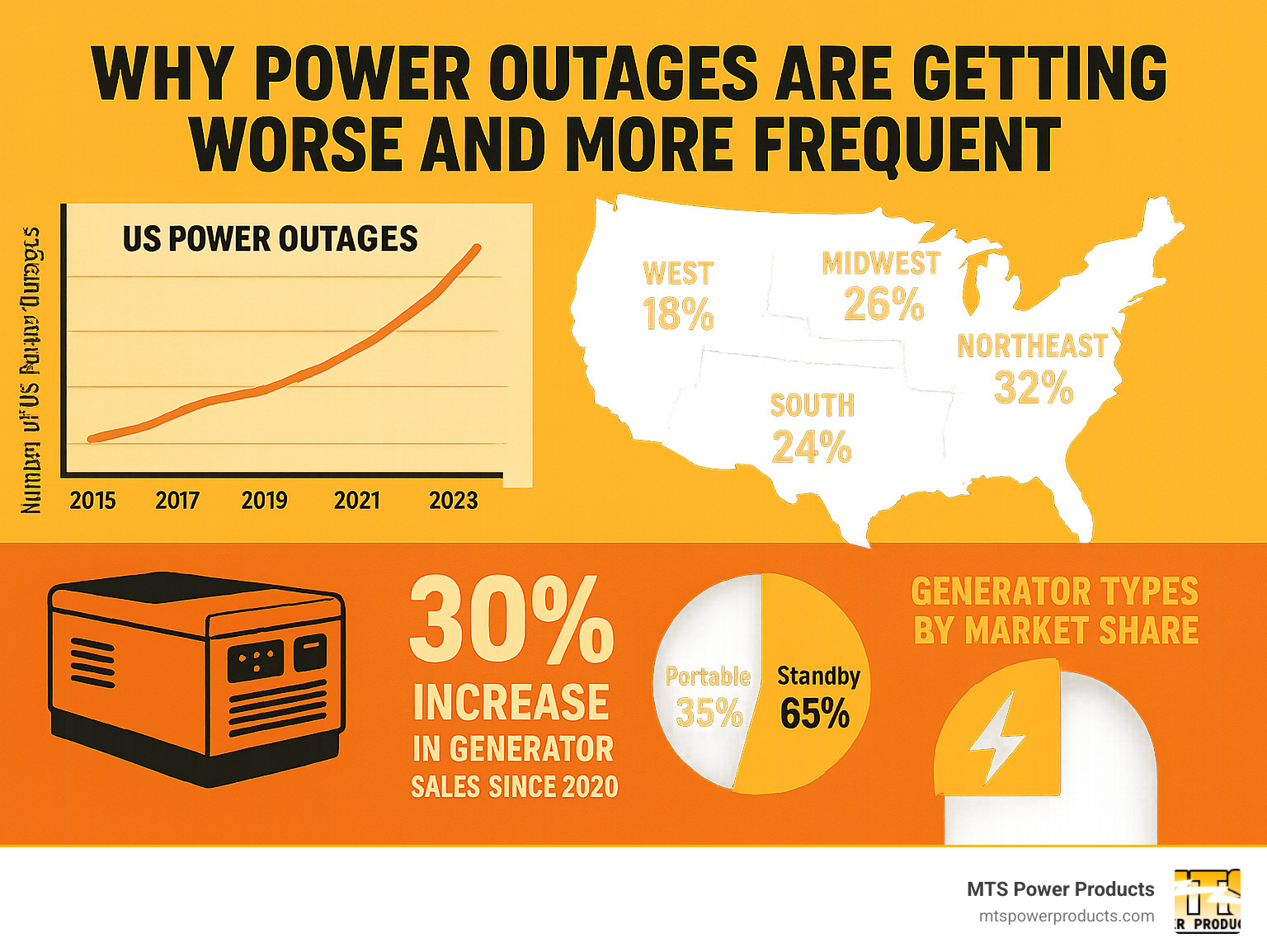
Emergency generators terms at a glance:
In our hyper-connected world, losing power is more than a minor inconvenience. It can mean a halt to business operations, hundreds of dollars in spoiled food, and a loss of comfort and security at home.
The financial impact hits immediately. When manufacturing facilities lose power, production stops while payroll continues. Small businesses and home offices face lost income and potential data loss. Even a few hours without power can translate to thousands in lost revenue—money that emergency generators help protect.
During extended outages, a fully stocked family refrigerator represents $200-400 worth of food that can spoil within hours. The increasing frequency of outages can lead to significant annual losses that a reliable backup power system prevents.
Home security systems depend on electricity. When the power goes out, so does your protection. Alarm systems, security cameras, and automated lighting all fail when neighborhoods are most vulnerable, creating a window that criminals can exploit.
For families managing medical conditions, emergency generators are essential for survival. Oxygen concentrators, CPAP machines, insulin refrigeration, and home dialysis equipment all require uninterrupted power. When the grid fails, backup power becomes a literal lifeline.
Generators provide peace of mind. Knowing your family will stay comfortable, your business will continue operating, and your essential systems will keep running allows you to focus on what matters most during a power failure.
Florida residents understand this reality well. The state’s unique weather challenges make backup power essential for maintaining normal life. You can learn more about the importance of a Generator in Florida and why so many Sunshine State families consider them non-negotiable.
The bottom line is simple: emergency generators have evolved from luxury items to necessary infrastructure. They’re investments in financial security, family safety, and business continuity that pay for themselves the first time you need them.
When it comes to selecting the perfect emergency generator, the decision doesn’t have to feel overwhelming. At MTS Power Products, a manufacturer and direct source for professional-quality generator sets, we understand that every power need is unique and have helped customers in South Florida and beyond for years.
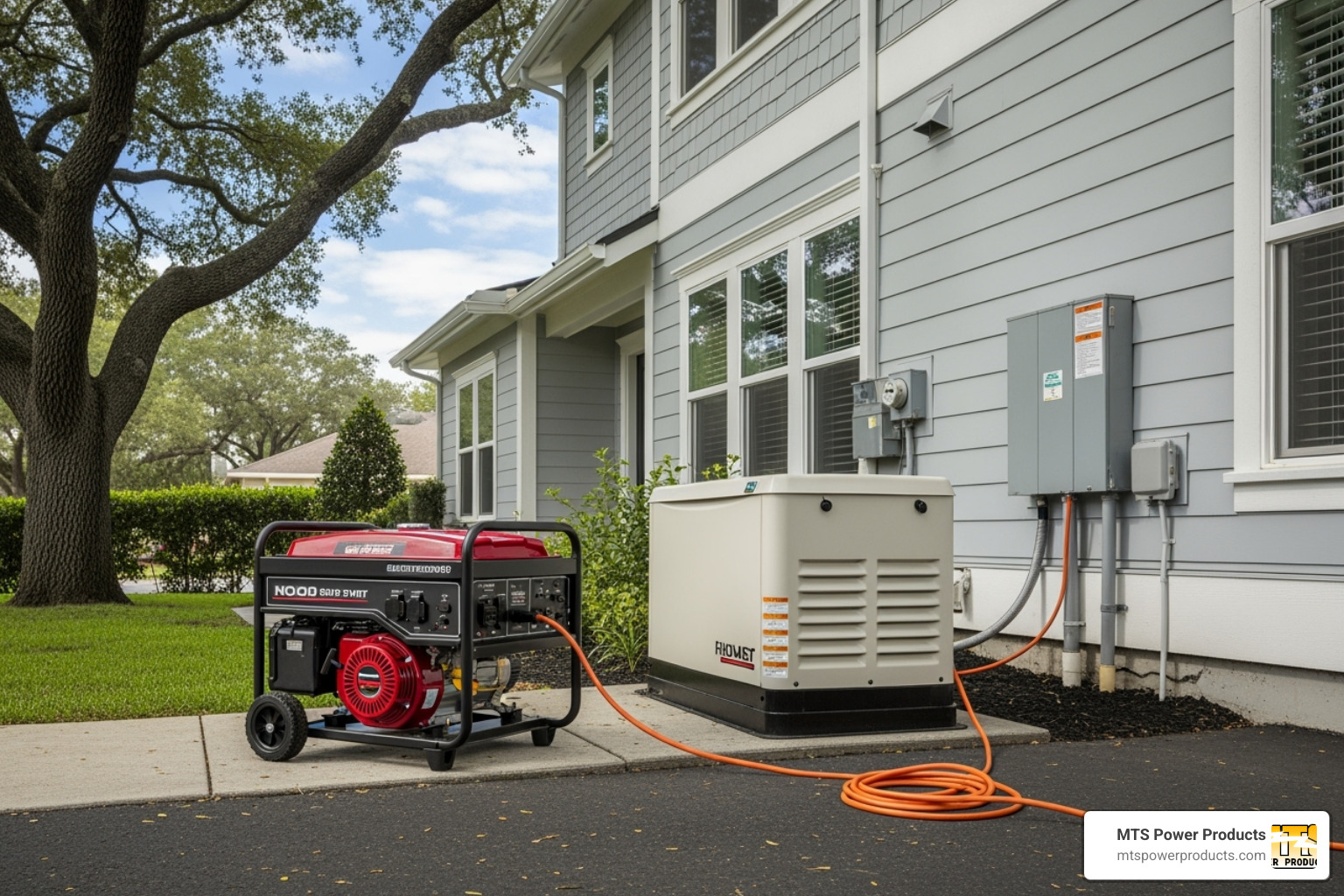
The key is understanding your specific power requirements. Are you looking to keep essentials running during hurricane season, or do you need a robust system to power an entire facility without interruption?
Our customized line of professional quality commercial and residential power controls, McPherson Controls, integrates advanced features like programmable displays and switch mechanisms. This provides improved control and safety features that make operating your generator both easier and more secure.
| Feature | Portable Generators | Standby Generators |
|---|---|---|
| Cost | Generally more affordable upfront investment | Higher initial investment but long-term value |
| Power Output | Typically 1,000-15,000 watts for essential appliances | High capacity 7,500-22,000+ watts for whole facilities |
| Installation | Manual setup with extension cords or transfer switches | Professional installation with automatic transfer switch |
| Convenience | Manual starting and refueling required | Automatic operation with seamless power transfer |
| Mobility | Easy transport for multiple locations | Permanent installation for reliable backup |
The choice between portable and standby emergency generators comes down to your needs for flexibility versus automation.
Portable generators offer maximum flexibility. They are perfect for job sites, recreational activities, and emergency home backup. The beauty of portability means you can move your power source wherever it’s needed most. These units require manual setup and refueling, which gives you hands-on control over your backup power. For comparison, see Honda EU2200i and Yamaha EF2200iS inverter models.
Standby generators are the “set it and forget it” solution. Once professionally installed, these systems monitor your power 24/7. When an outage hits, they automatically start and restore power to your home or business within seconds. The demand for home backup generators has jumped 30% since 2020, driven by the reassurance of knowing power will return automatically, even if you’re not home. Compare with Generac Guardian Series and Cummins QuietConnect.
For deeper insights into backup power solutions, check out What are Backup Generators MTS.
Your fuel choice impacts runtime, maintenance, and convenience. We offer generator sets powered by the most reliable and efficient fuel types available.
Diesel generators are the workhorses of power generation. Diesel fuel offers a high energy density for longer runtime and better fuel efficiency. It also stores well for months without degrading like gasoline, making these generators popular for commercial applications and serious home backup systems. See commercial diesel options from Kohler for reference.
Natural gas generators offer ultimate convenience by connecting directly to your existing gas line for a virtually unlimited runtime. This eliminates refueling and fuel storage concerns while producing cleaner emissions. They are ideal for standby installations where hands-off operation is desired. Example: Generac natural gas standby generators.
Propane generators have their own advantages. Propane can be stored indefinitely without degrading, burns cleanly, and is available in tanks that are easy to store safely. Learn more about this versatile option in our guide to Fuel Fight LPG Emergency Generators. Also see Briggs & Stratton Home Standby Generators, which can run on natural gas or liquid propane.
When choosing a fuel type, consider local availability during emergencies, storage capacity, and typical outage duration. For a comprehensive comparison, visit Emergency Generator Fuel Types.
Why limit yourself to one fuel source? Multi-fuel emergency generators are increasingly popular because they provide options when one fuel type becomes scarce during an extended outage. With a multi-fuel generator, you can simply switch sources and keep your power running.
Dual-fuel generators that run on both gasoline and propane now account for about 60% of sales in the portable generator market. This popularity stems from having backup options for your backup power. Popular competitor examples include Champion dual‑fuel generators, Westinghouse dual‑fuel portables, and DuroMax tri‑fuel models.
This flexibility is useful beyond emergencies. You might prefer using propane for its clean-burning and storage advantages but want the option to use gasoline if you need to refuel quickly. Propane storage benefits are particularly appealing, as it maintains its quality indefinitely. Meanwhile, diesel and natural gas availability varies by region, making multi-fuel capability even more valuable.
We encourage you to explore our comprehensive range of power solutions at MTS Power Products to find the perfect multi-fuel option that matches your specific needs.
Once you’ve decided on the type and fuel, understanding key features is the next step to selecting an emergency generator that meets your demands. Every detail, from wattage to safety features, matters for reliable backup power.
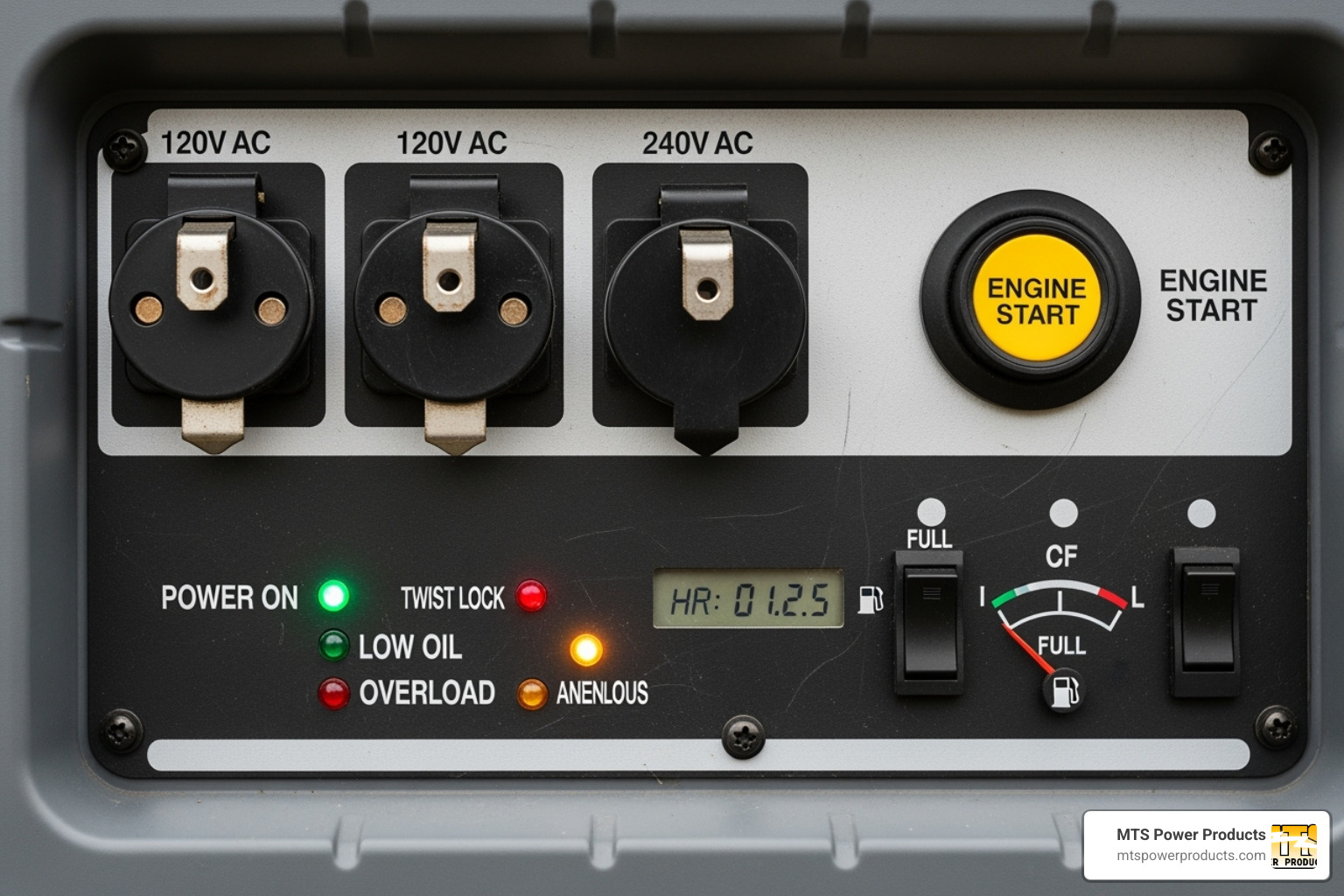
Calculating your wattage correctly is critical to avoid costly mistakes. Appliances require two types of power: running watts for normal operation and starting watts (or surge watts) for the extra burst needed to power up motor-driven items like refrigerators or sump pumps. This starting surge can be 2-3 times higher than the running power.
For example, a refrigerator might need 700 running watts but 2,100 starting watts. A sump pump could require 1,300 running watts and 2,900 starting watts. An HVAC system might draw 1,500 running watts with a 4,500-watt startup surge.
To calculate your needs, list every essential appliance you want to power simultaneously. Add up all the running watts, then add the single highest starting wattage requirement to that total.
Always add a 20% buffer to your final calculation. Overloading a generator can cause overheating and permanent damage, so having extra capacity is safer than pushing a unit to its limits.
Modern emergency generators offer more than just raw power; they include features that improve safety and usability. Look for these key additions when shopping.
Clean power from inverter technology is a must-have for running sensitive electronics like laptops, smartphones, or medical devices. It produces stable electricity that won’t damage delicate circuits. For example, Honda EU-Series and Yamaha EF Series inverters are known for especially clean output.
Electric start simplifies operation to a simple button push, making the generator accessible for anyone to start, even in the dark.
Safety features are non-negotiable. CO Alert sensors automatically shut down the generator if dangerous carbon monoxide levels are detected, a potentially life-saving feature. See Generac COsense and Briggs & Stratton CO Guard implementations. Automatic voltage regulation (AVR) keeps power output steady to protect appliances from damaging fluctuations. GFCI outlets are essential for preventing electrical shocks, especially in wet conditions.
For more detailed information about standby systems specifically, check out our Standby Generator Facts by MTS.
The right accessories can transform your emergency generator into a complete backup power system. At MTS Power Products, we offer a range of accessories to optimize performance and ensure safe operation.
Generator cords are crucial for safety. These heavy-duty cords are designed to handle high power loads, as using standard extension cords can create fire hazards.
A transfer switch is a game-changer for home use. Our Generator Transfer Switch Complete Guide explains how to safely connect your generator to your home’s electrical system, preventing dangerous back-feeding and simplifying operation. Competitor example: Reliance Controls transfer switches.
Generator covers protect your investment from rain, dust, and UV damage, which is especially important in South Florida. For portable units, wheel kits make moving a heavy machine much easier. For running covers, consider GenTent.
Finally, keep maintenance supplies like quality engine oil on hand. This ensures you can perform routine maintenance without scrambling for supplies during an emergency.
Owning an emergency generator brings peace of mind, but also responsibility. Proper safety practices and regular maintenance are essential for protecting your family and ensuring your generator is ready when you need it most.
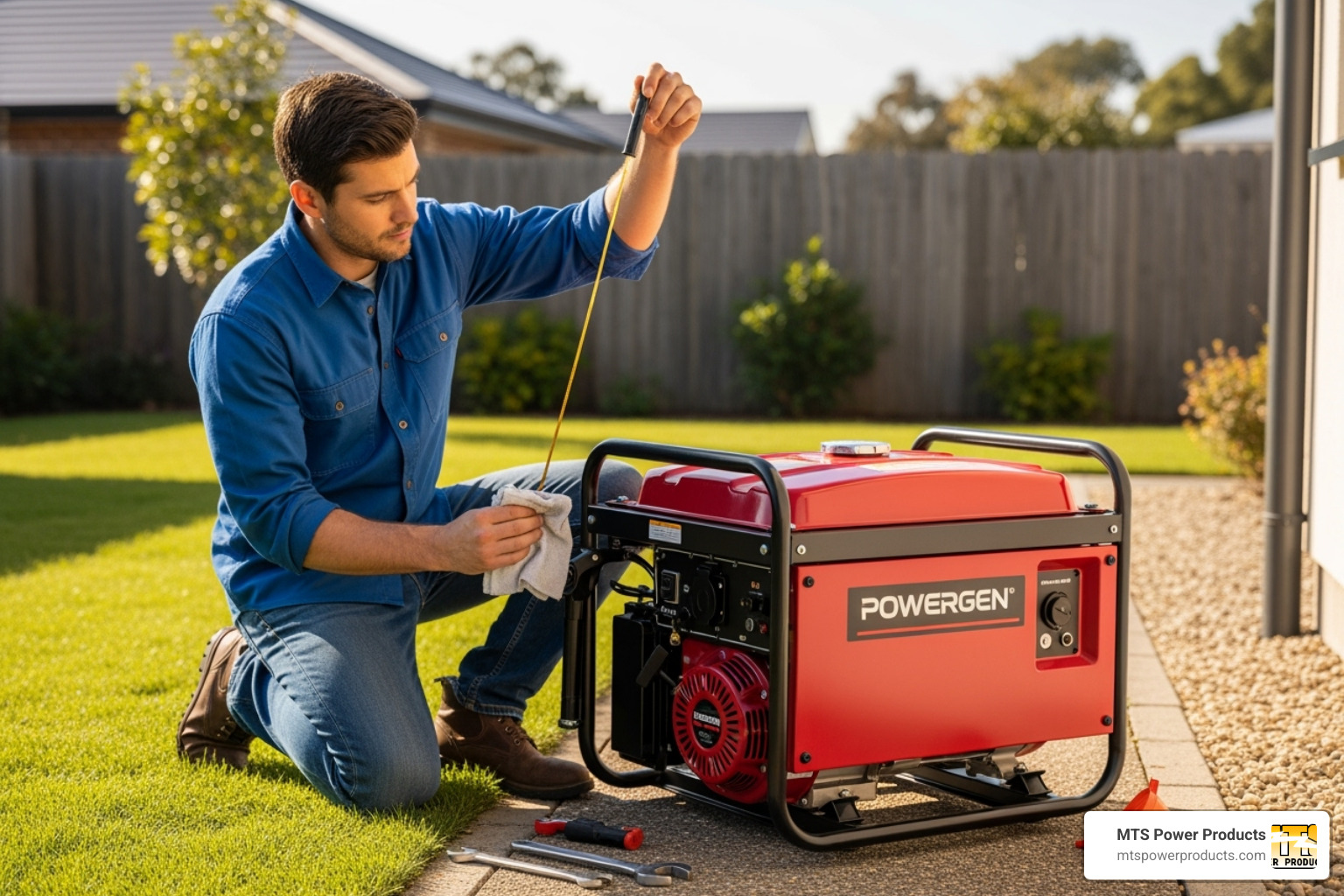
There is no room for shortcuts on emergency generator safety. The biggest threat is not mechanical failure, but carbon monoxide (CO)—a colorless, odorless gas produced by the engine’s exhaust that can be lethal in enclosed spaces.
The 20-foot rule is a lifesaver. Always position your generator at least 20 feet away from your home, with the exhaust pointing away from windows, doors, and vents. Never run a generator in a garage or enclosed space, even with the door open, as this can be fatal.
While weather protection is important, ventilation is critical. Use a generator cover or shelter that allows for adequate airflow. Always shut down the generator and let it cool completely before refueling to prevent a fire hazard from hot engines and gasoline.
For comprehensive safety guidelines, we strongly recommend you read more on generator safety from the Electrical Safety Foundation International.
A simple maintenance routine ensures your emergency generator is always ready for action. It’s easier to perform than you might think and goes a long way toward ensuring reliability.
Perform a weekly visual inspection. Look for fuel leaks, check that battery terminals are clean and tight, and verify the oil level. These quick checks can catch small problems before they become major issues.
Conduct a monthly test run for 10 to 30 minutes under a light load. This circulates the oil, keeps the battery charged, and ensures all components are working. It also helps you stay familiar with the startup process.
Before and after storm season, perform more thorough seasonal maintenance. Change the oil, inspect and replace the air filter if dirty, and check the spark plug for wear. Refer to your owner’s manual for specific service intervals.
Keeping the right parts on hand is part of good maintenance. At MTS Power Products, we stock a comprehensive selection of Generator Repair Parts to keep your unit running at peak performance. The best time to replace a worn part is before it fails.
Choosing an emergency generator involves many technical details. Here are answers to the most common questions we receive from customers to help clarify the process.
Start by walking through your home or business and listing everything you need to run during an outage. For each appliance, find its running watts (continuous use) and starting watts (the initial power surge for motors). A refrigerator, for example, might use 700 running watts but need 2,100 starting watts.
To calculate your total need, add up all the running watts for the items you’ll power simultaneously. Then, find the single appliance with the highest starting wattage and add that number to your total. Finally, add a 20% buffer to prevent the generator from running at maximum capacity, which can cause damage. Calculating correctly prevents the frustration of an overloaded generator during an outage. Online sizing calculators are a great tool to double-check your math.
The choice between portable and standby emergency generators is about versatility versus automation. Portable generators are versatile, affordable, and can be moved where needed, but require manual setup and refueling. They are ideal for powering specific circuits or for use on job sites.
Standby generators are permanently installed units that automatically sense a power outage and turn on within seconds, seamlessly restoring power to your entire home or business. While they represent a higher initial investment due to professional installation, their automatic operation provides invaluable peace of mind in areas prone to frequent or extended outages.
Noise levels are an important consideration. Emergency generators typically produce between 50 and 85 decibels (dB). For perspective, 50-60 dB is similar to a normal conversation, while 65-75 dB is comparable to a vacuum cleaner. Larger standby units can sometimes exceed 80 dB, approaching the noise level of a lawn mower.
Inverter generators are the quietest, usually operating in the 50-60 dB range. Standard portable generators typically fall between 65-75 dB. Before buying, check your local noise ordinances and consider the impact on your neighbors, especially during a nighttime outage. Generator technology continues to improve, with newer models becoming progressively quieter. As a quiet benchmark, the Honda EU2200i is rated at 48–57 dB.
When the next storm rolls through or the grid fails unexpectedly, you’ll be grateful you took the time to prepare. Throughout this guide, we’ve seen how emergency generators have evolved from nice-to-have conveniences into essential equipment for modern life. The statistics are clear: power outages are becoming more frequent and more costly, while our dependence on electricity continues to grow.
The peace of mind that comes with reliable backup power is truly priceless. Whether you’re protecting your family’s comfort during hurricane season, keeping your business running when competitors are forced to close, or ensuring life-saving medical equipment stays operational, the right generator solution makes all the difference.
At MTS Power Products, we understand that every power need is unique. That’s why we’ve built our reputation as South Florida’s premier source for professional-quality generator sets, control panels, and voltage regulators. Our team doesn’t just sell equipment – we create customized solutions that fit your specific requirements.
What sets us apart? Our advanced McPherson Controls line integrates programmable displays and switch mechanisms that deliver improved control and safety you simply won’t find elsewhere. When you work with us, you’re getting direct access to manufacturer-quality products without the middleman markup.
Being prepared isn’t about living in fear – it’s about taking smart, practical steps to protect what matters most. From our location minutes from Miami International Airport and the Port of Miami, we deliver professional power solutions worldwide. We’ve helped countless families and businesses stay powered when others went dark.
Don’t wait until you’re sitting in the dark, watching your food spoil and your security system fail. Take control of your energy independence today. Explore our full range of commercial backup generators and find why there’s no better company in South Florida for custom generators, transfer switches, and complete power solutions.
Your future self will thank you for making this investment in preparedness and peace of mind.
